When this Iceplant is in bloom, the shiny lavender flowers practically knock your eyeballs out! Vigorous and hardy. Firewise.
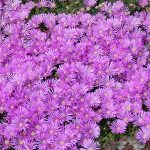
- Lavender Ice Iceplant
- 5
- Sun
- 2” x 12”
- South Africa


When this Iceplant is in bloom, the shiny lavender flowers practically knock your eyeballs out! Vigorous and hardy. Firewise.
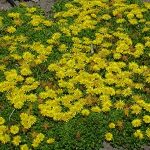
Hardy Iceplant is a fast-growing, mat-forming succulent, lovely garden accent. Bright yellow daisy-like flowers appear in late- spring. fall. Bright-green knobby leaves turn bright red during the winter. Avoid overwatering and excessive winter moisture. Firewise.
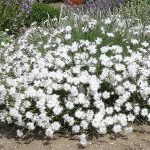
Sand Pink forms large hummocks packed with narrow evergreen foliage. In late spring it is covered with extremely fragrant little white flowers like snowflakes. Attracts butterflies. Firewise.
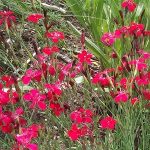
‘Flashing Lights’ Dianthus (Pink): This evergreen dianthus is not pink, but a deep, brilliant red. The mound of narrow, dark green, grassy leaves is attractive year-round. Great for low edging at the front edge of a bed or in a rock garden. Attracts butterflies. Firewise.
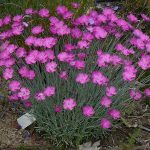
‘Firewitch’ Dianthus (Pink) is a bouquet of electric magenta flowers with frilly edges over a mound of attractive gray-green foliage. Excellent rock garden plant, or use at the front of a border. Attracts butterflies. Firewise.
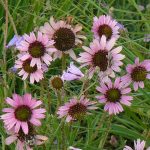
Shorter than other Echinaceas, Tennessee Coneflower cheerfully faces the rising sun and blooms like crazy–even despite heat and low water. Native to dry, rocky areas in Tennessee, it does well in the Intermountain West.
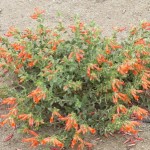
The red tubular flowers are a magnet for Hummers in the late summer and early autumn, as these tiny birds prepare for their annual migration. Adaptable to many soil types and low water, Hummingbird Trumpet provides a spectacular splash of color in the late season garden.
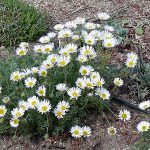
Cutleaf Daisy is a vigorous, long-blooming native Fleabane with dissected leaves and bundles of charming white flowers. Excellent for rock gardens or exposed slopes with good drainage.
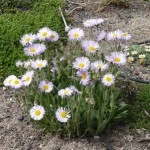
Beautiful Fleabane is a low-growing, early-blooming native daisy. Forms ever-widening patches over the years. Cheerful purple flowers attract pollinators.
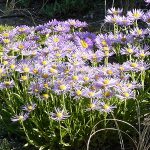
Showy Fleabane is an erect native Daisy (or Fleabane) with narrow leaves and cheerful purple that flowers in early to mid-summer. Usually occurs in woodland openings or edges. Attracts native bees and butterflies.
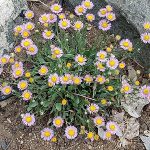
Tidy mounds of delicate lavender flowers with yellow centers. Choice rock garden or edging plant.
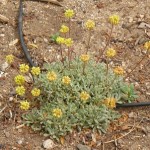
A beautiful mat-forming buckwheat topped with delicate round flowers–pale yellow, fading to pink or orange. Excellent rock garden plants. Supports native bees. Choice!
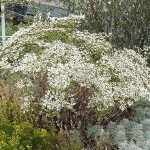
The largest of our Buckwheats, Lacy Buckwheat is an amazing fall bloomer. It forms large domes of finely divided woody branches that are covered with tiny white flowers Sep-Oct. Stunning! Supports honeybees and native bees. Prefers sandy/gravely soils and will tolerate poor soils. More information here.
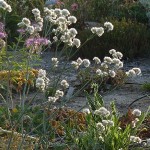
An amazingly statuesque Buckwheat! Add elegant structure to your xeric flower garden with this native beauty! Off-white flowers top the long stalks in mid-summer.
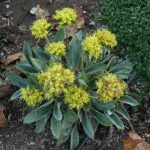
A compact high elevation Idaho buckwheat with narrow leaves and charming yellow flowers.
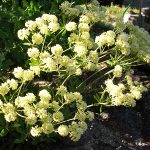
Whorled Buckwheat has leathery leaves which form a basal mat sending up brilliant white, cream color pom-poms in early summer. Likes well-drained soil. Boise foothills native. Pollinators: butterflies, bees.
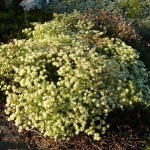
This Buckwheat forms large, dense mats covered with cream-colored to yellow flowers. It blooms during the heat of mid-summer when many other Buckwheats are done. Supports native bees.
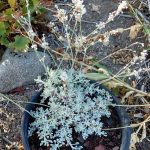
Dense, flat clusters of tiny, woolly, gray-green leaves sending up spikes of airy white flowers in late summer. This gorgeous little Buckwheat is native to the Sierra and Western Great Basin of California. Lovely in a rock garden.
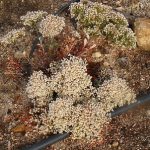
This small Idaho native is covered with hundreds of pinkish white flowers in late summer or early fall. Gorgeous rock garden plant.
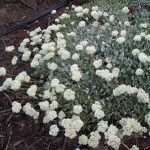
This Buckwheat features white pom-pom like flowers over expanding tuffets on tight gray-green leaves. Choice!
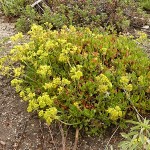
This beautiful little plant appears to be a variety of Sulfur Buckwheat. Its sculpted leaves and diminutive shrubby form make it an outstanding rock garden plant. Blooms earlier than our regular Sulfur Buckwheat.
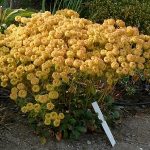
Sulfur Buckwheat is arguably the best all-around landscape plant native to S. Idaho. Bright yellow flower heads rise over a mat of spoon-shaped leaves and mature into a lovely copper color over the summer. The basal leaves turn reddish-green in the fall and are attractive all winter long. Boise foothills native. Pollinators: butterflies, bees. Firewise.
A dense carpet of gray-green leaves topped with a cloud of delicate pinkish-white blossoms. Rock gardens. Tolerates clay.
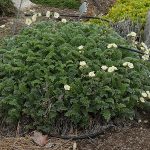
Yellow Stork’s Bill grows into long-lived, beautiful mounds of graceful foliage that are nearly evergreen. Delicate pale yellow flowers pop up in the early summer. Doesn’t mind heat and lean soil.
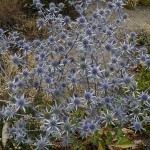
Amethyst Sea Holly has leathery, blue-green leaves with medium-tall stems bearing striking thistle-like, steel-blue flowers and matching bracts. The flowers appear in mid summer and remain effective until fall. An eye-catching garden accent!
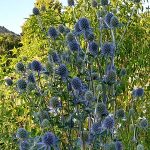
Steel blue thistle-like flowers on branched stems. Beautiful garden accent and cut flower. Thrives in poor soils.
Idaho Fescue is a short, tufted bunchgrass with grey-blue blades. Cool season grass, grows early in spring and stays green in winter. Nice garden accent year-round. Avoid over-watering or fertilizing. Firewise.
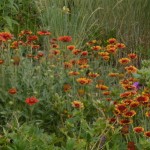
Cheerful red flowers with yellow tips. Adaptable and reliable, this native wildflower blooms for most or all of the summer. Give haircut to in mid-summer to promote more flowering. Will seed out without being invasive. Tolerates a wide variety of soil types. Pollinators: native bees, honey bees. Firewise. More information here.
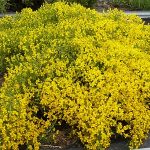
Lydia broom, a well-behaved flowering shrub, is a stunning sight in late spring,–covered with bright yellow pea-like flowers. Otherwise, the evergreen mound of wiry stems provide good structure year round. Tolerates clay. Don’t confuse with invasive Scotch Broom. Choice!
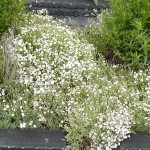
Creeping Baby’s Breath is a delicate spreading ground cover, creeping around other plantings and falling down walls. Covered with a burst of pink or white blooms, late spring. Easy and rewarding.
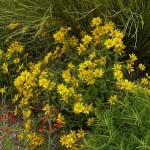
Cheery daisy-like flowers continue blooming all summer, especially beautiful in informal native or prairie gardens. Can seed out but is easily controlled. Tolerates some shade. More information here.
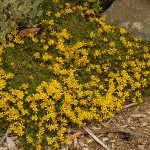
Jones’ False Golden Aster is a little known dwarf aster from southern Utah. Gradually spreads to form flat mats of gray-green leaves studded with bright yellow daisies all summer. A fantastic rock garden plant, it thrives in the heat requires little moisture and is not invasive.
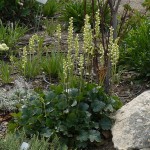
Coralbells has dramatic spikes of cream to white flowers rise from a base of scalloped deep green leaves. Favors rock outcroppings; great in full sun or dry shade. Very long blooming in our Boise garden. Firewise. Choice! More information here.
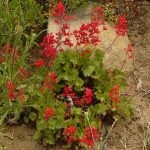
Alpine or Red Coralbells is another charming native Heuchera, this one with deep red to pink flowers on delicate wands. Great for full sun or dry shade. Sculpted evergreen foliage. Firewise.
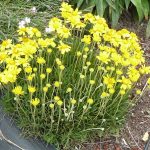
Sundancer Daisy is a cheerful, showy, long-blooming western wildflower and is a gem in the xeric garden. The attractive thread- leaf foliage is covered by bright-yellow, long-stemmed daisies in summer. Remarkably adapted to arid regions, from low desert to mountains. More information here.
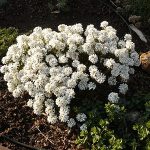
Very low growing, evergreen cushion with dark green leaves and large, white flowers in spring that can fade to lilac. Sun, very well-drained soil.
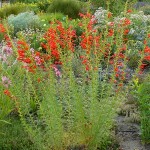
This fantastic biennial, native to Texas, produces a profusion of tubular red flowers in the second summer. Closely related to our native Scarlet Gilia, it is proving to be more reliable in cultivation. And, being from Texas, it is naturally bigger, bolder and showier. A real magnet for Hummingbirds
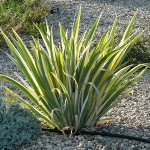
Grown for its striking foliage, this Iris also produces a lovely lavender flower in late spring.
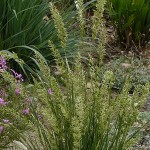
Prairie Junegrass is a native, perennial, cool season tufted bunch grass , growing actively when soil temps are cooler in spring and fall. It produces lustrous silver-green seedheads in early summer. The supporting foliage is an attractive green-gray color. June Grass prefers full sun and dry, sandy soil. More information here.
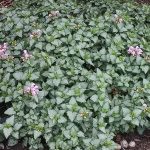
A groundcover that loves shade! Its variegated leaves light up a dark shady area, yet the plant will also grow in sun. Not picky about soil type or moisture.